 Identify the structure surrounding the arrow:
Identify the structure surrounding the arrow:
Question 1 - Single Best Answer
 Identify the structure surrounding the arrow:
Identify the structure surrounding the arrow:
A) adipocyte
B) thyroid follicle
C) alveolus
D) mucous acinus
E) lymphatic capillary
Question 2 - Single Best Answer
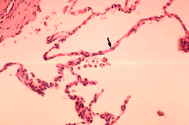 Identify the cell at the tip of the arrow:
Identify the cell at the tip of the arrow:
A) endothelial cell
B) type II pneumocyte
C) smooth muscle cell
D) type I pneumocyte
E) dust cell (alveolar macrophage)
Question 3 - Single Best Answer
A) esophagus
B) trachea
C) bronchus
D) bronchiole
Question 4 - Single Best Answer
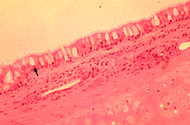 Identify the cell at the tip of the arrow:
Identify the cell at the tip of the arrow:
A) basal cell
B) clara cell
C) ciliated columnar cell
D) goblet cell
E) dust cell
Question 5 - Single Best Answer
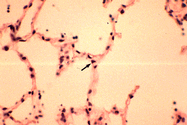 Identify the cell at the tip of the arrow:
Identify the cell at the tip of the arrow:
A) endothelial cell
B) type II pneumocyte
C) type I pneumocyte
D) smooth muscle cell
E) dust cell
Question 6 - Single Best Answer
A) bronchiole
B) bronchus
C) pulmonary artery
D) pulmonary vein
E) trachea
Question 7 - Single Best Answer
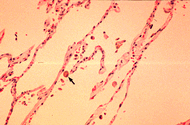 This slide comes from a patient who had emphysema and heart failure. Identify the cell and its contents at the tip of the arrow:
This slide comes from a patient who had emphysema and heart failure. Identify the cell and its contents at the tip of the arrow:
A) type II pneumocyte; surfactant
B) dust cell; anthracoid pigment
C) clara cell; surfactant
D) dust cell; hemosiderin
E) neutrophil; azurophilic granules
Question 8 - Single Best Answer
A) bronchiole
B) pulmonary vein
C) pulmonary artery
D) trachea
E) bronchus
Question 9 - Single Best Answer
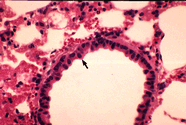 Identify the cell at the tip of the arrow:
Identify the cell at the tip of the arrow:
A) clara cell
B) type II pneumocyte
C) smooth muscle cell
D) dust cell
E) ciliated clumnar cell
Question 10 - Single Best Answer
A) bronchus
B) trachea
C) pulmonary artery
D) bronchiole
E) pulmonary vein
Question 11 - Single Best Answer
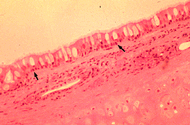 Identify the cell at the tip of the arrow:
Identify the cell at the tip of the arrow:
A) goblet cell
B) basal cell
C) lymphocyte
D) dust cell
E) clara cell
Question 12 - Single Best Answer
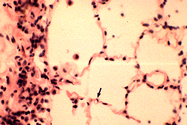 Identify the cell at the tip of the arrow:
Identify the cell at the tip of the arrow:
A) smooth muscle cell
B) dust cell
C) type I pneumocyte
D) endothelial cell
E) type II pneumocyte
Question 13 - Single Best Answer
A 12 year old white male presents with a history of wheezing and a cough. He also has diarrhea. Several other family members have had the same symptoms at one time or another. On physical exam, he has wheezing, clubbing of the fingers and toes(this is found in patients who have chronic lung disease), and nasal polyps. Because of his family history, cystic fibrosis is suspected. It is an autosomal recessive disease in which there is thick, copious secretions with increased amount of chloride ion. A sweat test is done. The chloride is 200 mEq/L(normal is <60 mEq/ L). Which structure would help to clear mucous from the airway?
A) goblet cell
B) cilia
C) dust cell
D) type II pneumocyte
Question 14 - Single Best Answer
Cultures of his sputum grew Staphylococcus aureus and Pseudomonas aeruginosa(bacteria). These microorganisms are usually found in the lungs of these patients. They cause inflammation of the lungs(pneumonia). Which item plays a direct role in the prevention of alveolar collapse?
A) surfactant
B) mucous
C) good air movement in the lungs
D) eating "Wheaties"
Question 15 - Single Best Answer
Asthmatics also wheeze. It is a phenomenon that occurs when the size of the airway decreases. With the patient above, mucous plugs are the cause. In asthmatics, there is smooth muscle contraction that decreases airway size along with inflammation/mucous. Which of the following is least likely to be affected during an asthmatic attack?
A) bronchi
B) bronchiole
C) alveoli
Question 16 - Single Best Answer
Emphysema is a lung disease which tends to occur after many years of smoking cigarettes. It is manifested as shortness of breath because the lung parenchyma is destroyed and therefore there are changes in alveolar volume. Which depicts emphysema?
A)
B)
C)
D)